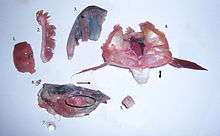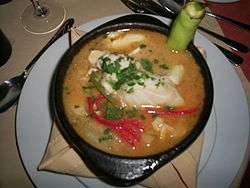Fish head


Fish heads, either separated or still attached to the rest of the fish, are sometimes used in food dishes, or boiled for fish stock.
Anatomy
The head of a fish includes the snout, from the eye to the forward most point of the upper jaw, the operculum or gill cover (absent in sharks and jawless fish), and the cheek, which extends from eye to preopercle. The operculum and preopercle may or may not have spines. In sharks and some primitive bony fish, a spiracle, a small extra gill opening, is found behind each eye.[1]
The skull in fishes is formed from a series of only loosely connected bones. Jawless fish and sharks only poses a cartilaginous endocranium, with both the upper an lower jaws being separate elements. Bony fishes has additional dermal bone, forming a more or less coherent skull roof in lungfish and holost fish. The lower jaw defines a chin.[1]
Cultural aspects

In Sicilian witchcraft, it is customary to leave a fish head on the door step of one's enemy to ward off malicious intention. It is also performed by the eldest grandma when a mafia fishing family has been wronged by a business partner. The practice dates back to at least 1308, when Dante referenced it in his epic, the Divine Comedy.
In a more serious feud, escalation of hostilities can be signaled by the appearance of a goat head or horse head.
There are many references to talking fish heads in various dream sequences featuring Tony Soprano in the HBO series The Sopranos.[2]
Fish heads gained notoriety in 2009 with a Green Peace publicity stunt in which members of the activist group dumped 5 tons of fish heads on the door step of the French Fisheries Ministry.[3]
As food
| Name | Image | Origin | Description |
|---|---|---|---|
| Caldillo de congrio |  |
Chile | Made from congrio Colorado (red conger), an eel species common in the Chilean Sea, by boiling together fish heads, onion, garlic, coriander, carrots and pepper. Once these are boiled, only the stock is used. Onion and garlic are fried together with chopped tomatoes. The vegetables are mixed then with the stock, liquid cream, boiled potatoes and marinated and boiled conger.[4] |
| Chhencheda | India | Made with crushed fish heads along with vegetables. The main ingredients are fish (generally Rohu or Tilapia) head and vegetables like eggplant, potatoes, tomatoes, zucchini (called Janhi in Oriya), onions, etc.[5] | |
| Crappit heid | Scotland | (English: stuffed head). Can be traced to the fishing communities of the North, Hebrides and North-Eastern Scotland in the eighteenth century. In a time when money was scarce, the more expensive fillets of fish, such as cod or haddock would be sold to market but the offal and less attractive parts were retained by the fisherfolk for the pot. | |
| Stargazy pie |  |
Cornwall | Made of baked pilchards, along with eggs and potatoes, covered with a pastry crust. Although there are a few variations with different fish being used, the unique feature of stargazy pie is fish heads (and sometimes tails) protruding through the crust, so that they appear to be gazing skyward. This allows the oils released during cooking to flow back into the pie.[6][7] |
| Fish head casserole | China | Prepared with a fish head (about 1 kg), bean curd, cayenne pepper, sesame oil, vegetable oil, garlic sprouts, shallot, ginger, soy, salt, cooking wine, white sugar and monosodium glutamate. The fish head is washed, marinated in soy sauce, and fried with cooking wine added. The head is then stewed and served garnished with garlic sprouts and sesame oil. The broth in this dish has a milky white colour.[8] | |
| Fish head curry | Malaysia | This dish had its origins in Singapore, when a chef wanted his South Indian-style food to cater to a wider clientele, notably Chinese customers who considered fish head a specialty. The head of a red snapper is semi-stewed in a Kerala-style curry with assorted vegetables such as okra and eggplant (brinjals), usually served with rice or bread. | |
| |
Indian | In India and Bengal where the staple is rice and fish, one very popular fish head curry is made with moog or ung beans but other vegetables can also be used. The gravy is very thick and very spicy. Rohu is most popular fish used for this dish. | |
| |
Peranakan | Peranakans are a group of ethnic Chinese. Today Peranakan restaurants serve variations of this dish. | |
| Muri ghantoo | Bengali | Made from rice and fish heads, usually the heads of rohu. It is not fully cooked, giving the dish a grainy texture. Used on festive occasions. | |
| Tepa | Yup'ik | Tepas, also called stinkheads, are fermented whitefish heads. A customary way of preparing them is to place fish heads and guts in a wooden barrel, cover it with burlap, and bury it in the ground for about a week. For a short while in modern times, plastic bags and buckets replaced the barrel. However this increased the risk of botulism, and the Yupik Eskimos have reverted to fermenting fishheads directly in the ground.[9][10] |
 Fish head (red tilefish) Japan
Fish head (red tilefish) Japan Braised fish head in pot
Braised fish head in pot Steamed salmon head
Steamed salmon head Mashed pepper fish head
Mashed pepper fish head
See also
Notes
- 1 2 Romer, Alfred Sherwood; Parsons, Thomas S. (1977). The Vertebrate Body. Philadelphia, PA: Holt-Saunders International. pp. 161–177. ISBN 0-03-910284-X.
- ↑ "HBO: The Sopranos, Season 2, Episode 26 "Funhouse."". Retrieved 2009-04-25.
- ↑ "Dead tuna heads for deadbeat tuna managers". Retrieved 2009-04-25.
- ↑ Caldillo de congrio recipe (in Spanish)
- ↑ www.odiakitchen.com
- ↑ Stargazy pie recipe and image
- ↑ Stargazy pie, description, history, recipe and image
- ↑ http://news.xinmin.cn/rollnews/2011/09/29/12245747.html
- ↑ p. 69, Subsistence salmon fishing in Nushagak Bay, Southwest Alaska, Jody Seitz, technical paper no. 195, Alaska Department of Fish and Game, Division of Subsistence, Juneau, Alaska, December 1990. Page 68.
- ↑ p. 5, Botulism in Alaska, a guide for physicians and healthcare providers, 2005 update, State of Alaska, Department of Health & Social Services, Division of Public Health, Section of Epidemiology.
External links
- Generalized fish heads University of California.
